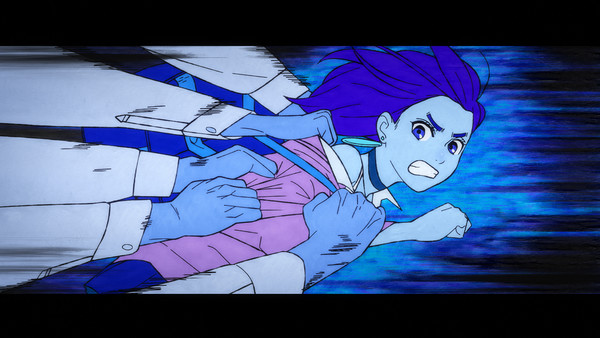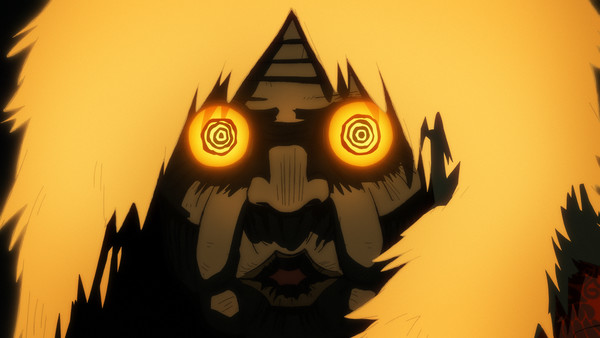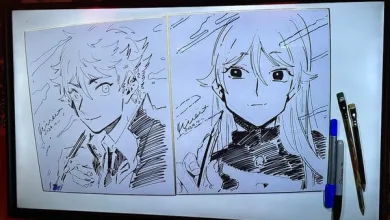From Page to Screen: DAN DA DAN Director Fūga Yamashiro and Voice Actor Shion Wakayama

© 龍幸伸/集英社・ダンダダン製作委員会
Creator Yukinobu Tatsu‘s DAN DA DAN manga has been a fan-favorite, deftly blending a smorgasbord of supernatural elements with comedy, romance, and intense fight scenes. Director Fūga Yamashiro and studio SCIENCE SARU had the unenviable task of translating the series for the screen. Adapting a high-profile work brings its own special kind of stress, but Yamashiro shared with us how he is infusing the television anime with his own passion and visuals that can only be achieved through animation.
Joining him for the interview is voice actor Shion Wakayama. Wakayama brings life to the reliable and psychically-gifted Momo Ayase, one half of the series’ dual protagonists. Fans likely know Wakayama from her past roles, including SSSS.Dynazenon‘s Yume Minami and Mushoku Tensei: Jobless Reincarnation II‘s Shizuka Nanahoshi.
Together, they discuss their favorite scenes from the first three episodes, the series’ tokusatsu visual connection, and whether they believe in ghosts (or aliens).
DAN DA DAN is a unique mix of horror, comedy, and romance. What first attracted you to this project, both as a director and as a voice actor?
Fūga Yamashiro: I like comedy the most. And I think out of all the genres DAN DA DAN is labeled with, it’s closest to being a comedy. So then, I think the relationship between Momo and Okarun is the key. You know, they’re buddies, but then there are some romantic moments. I think their banter really adds to that comedic timing.
I think the changes in how they’re conversing, going from comedy to romance to action, is really fun to watch as a viewer. Even if they’re thrown into unusual or scary situations, they keep that same atmosphere with each other. And then [it’s through that] bantering, [they] sort of figure it out and can overcome [those situations].
I think that’s the appeal of the DAN DA DAN. As you said, there are different genres mixed into this title. So I think, to emphasize a certain genre, like, let’s say comedy, I want to make sure that the horror is thrown in and then going full out with the horror but then bringing in the action and then comedy. I think the contrasting genres shown and the speed at which they’re showcased were really important to the creation of the anime. That’s what I really focused on.

© 龍幸伸/集英社・ダンダダン製作委員会
Shion Wakayama: Yeah, I really like the comedy aspects the most as well. So, in Japan, when we do the ADR recording, we do a test first and then actually record the lines. But I practice at home with my lines, then go to the studio and record the lines. When I practice at home, I’m obviously doing it alone. And then, at the studio, we finally get to see everyone else in the cast, including Okarun. And then, for the first time, my dialogue becomes a conversation. Then, quickly, the conversation makes sense, and it clicks.
That was really fun. I went to the studio every time, looking forward to it and having fun. And among those, the comedic dialogue was the most fun.
My next question is a little bit fun, but I was wondering for both of you personally, are you a believer in UFOs or ghosts? Have you had a supernatural experience?
[Both laugh]
YAMASHIRO: No experience whatsoever for me, but I would like to see something. Japan is so superstitious, especially regarding curses or karma. So everyone would say to me, you know, “You’re so involved in a title that deals with yokai and curses. Are you gonna be okay? Shouldn’t you go to the shrine and ward off evil?” But my answer was always “No, no, no. I’m completely focused and dedicated to this project, so I should be fine.” They would relent because I’m so dedicated.
WAKAYAMA: So I tend to believe in UFOs and ghosts. I’ve never seen a UFO myself, but I’ve had mysterious experiences before. Like, when I think, “Oh, is someone behind me?” but there’s no one there. Or like if I’m in my room and I think, “Wait, did someone or something pass by?” I don’t have any spiritual powers or anything, but I think I’m hoping for something.
YAMASHIRO: Yeah, I think I have something like a sixth sense, too. I get a feeling production will say something about the deadline soon, and then they do. [laughs] But production might think I’m the curse. [laughs]
You showed your very impressive reference notebook in the behind-the-scenes video included with the first three episodes. Were there any film composition references from that notebook used in the first three episodes of DAN DA DAN?
YAMASHIRO: Generally, I don’t use anything from the references in my projects. I can’t use them directly, which is why. However, I tend to read the reference notes for brain exercises. So then I try to pick up the pieces like, “Okay, so if I want to show something scary, there’s this example, and then there was this example, and there’s this example.” I tried to pick up the pieces and then combine them. Doing this brain exercise does help come up with new things. So there’s nothing you can find in the first three episodes directly taken from the reference notebook.

© 龍幸伸/集英社・ダンダダン製作委員会
I was also wondering if you could discuss the decision for most of the fight scene in episode two to be depicted in black and white. I thought that was very interesting.
YAMASHIRO: I think the juxtaposition of the different elements was really important in DAN DA DAN. I wanted to really include contrast in the anime. When the characters are thrown into unusual situations like fighting aliens or yokai, et cetera, I thought, “What’s an easy way to see that they’re thrown into a completely unusual situation?”
I thought, “Okay, well, then I could just change the colors. Okay, then, how do I change the colors?” Then I went back a little bit with each alien, ghost, or yokai and had these theme colors assigned to each character so that when that alien or ghost is taking over, I would flush the screen with their color [to show] that they’re taking control of the situation. So if it’s a black-based monster or enemy, [the screen will] be mostly black.
In this case, in episode two, black was assigned to the villain, but it’s also when Okarun has his first henshin [transformation] scene, right? So, I read somewhere that [DAN DA DAN] manga creator [Yukinobu] Tatsu-sensei is a fan of Ultraman, like nostalgic for the early Ultraman days. So I thought, “Well, if he’s gonna be fighting aliens, Okarun would be Ultraman.” Ultraman is really known for red and silver, especially the red. I wanted to make the red part stand out. So [in the episode], there’s the alien’s assigned color in addition to having the whole composition in black and white. When Okarun transforms, that red stands out.

© 龍幸伸/集英社・ダンダダン製作委員会
YAMASHIRO: Going back to the assigned colors, in future episodes, you’ll see someone assigned green, and then green will fill the screen.
So, the aliens in episode one would be blue?
YAMASHIRO: Yeah. Going back to why episode two was mostly in black and white. When Ultraman was first shown, they filmed it in color, but everyone only had black and white TVs. So then, people back in the day would only see Ultraman in black and white. So most people, I mean, there were color TVs out there back in the day, but most people, like, most civilians or most common people, only had black and white TV. So, like, that was the majority of how people. Ultraman. I wanted to recreate that, pick up that Ultraman likeness, and incorporate that into the episode.
Of the scenes in the first three episodes, which was the most challenging, and which are you particularly proud of?
YAMASHIRO: Yeah, I think I do have a scene that was really successful; that I thought was the best. It’s when Okarun finds Turbo Granny.
[Yamashiro turns to his producer]
Don’t you think it was the best?
Producer: Okay, yeah, sure. [Everyone laughs]
YAMASHIRO: It’s from episode one when Okarun finds Turbo Granny; from that scene to when it cuts to the commercial. It was the most successful and best scene, in my opinion, within the first three episodes. Why? It was because it was very difficult. After all, there are cutbacks to Momo and Okarun, so there’s a focus on both. There couldn’t be one person who had more focus than the other. I thought of both of them as protagonists; both of them have to carry the emotional weight of the show. So I asked myself, “How do I make sure to give them both weight, but they both overcome it?” They’re both in danger. But the balance, I was really careful on how to depict that. In the manga, it’s showcased a little differently. It was really like my idea for this animation, which was really hard. I really think the animation [in that part] is god-like.
This is why I’m so dedicated to the show, and this is why I will not be cursed by it. [Laughs]
I can tell you’re very passionate about it.

© 龍幸伸/集英社・ダンダダン製作委員会
WAKAYAMA: I think I had a lot of firsts in episode three. I did a lot of new things and had a lot of challenges, and I want to speak about them. Episode three is a full-on 20-something-minute battle, which was a first for me. That was a huge challenge. But also, in episode two, she’s thrown against the wall, and she’s so tattered and, like, torn. But she still has to speak this awesome dialogue. So that was a first [for me]. I was really, like, “Okay, so how do I make sure that I speak in an awesome way?” But then she’s also tattered and broken. So I really practiced at home, “Is it this way? Is it this way?” I tried different things, but I think everything was a challenge. But I think the battle scenes or the speaking in the battle scenes were especially challenging.
Well, I thought Momo in that scene was very cool.
WAKAYAMA: Thank you very much!
The DAN DA DAN staff held the U.S. premiere of the first dubbed episode at Anime NYC. DAN DA DAN: First Encounter, a theatrical screening of the first three episodes, will debut with screenings in Asia on August 31, in Europe on September 7, and in North America on September 13-15.
Source link
#Page #Screen #DAN #DAN #Director #Fūga #Yamashiro #Voice #Actor #Shion #Wakayama




